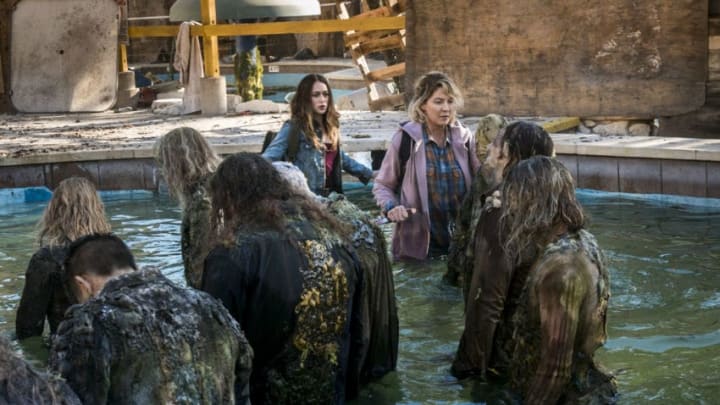Through its creative use of color, Fear the Walking Dead season 4 has presented fans with more than just a zombie story. It’s a master class on film technique.
Fear the Walking Dead has been many things over the course of its four seasons, but never has it had the artful quality that it has in season 4. The new look and feel of the show is in large part thanks to new showrunners Andrew Chambliss and Ian Goldberg, who have crafted a tale of two timelines using color as the narrative force guiding the story along.
In Fear, the use of color shows a bright past, full of hope and optimism after a hard-fought battle (presumably) to finally settle in a safe place. The present, as we have seen, has a very different look. Colors are muted, and it’s almost black and white. If the past was full of optimism, then the present is full of dreariness and desperation.
More from Undead Walking
- Walking Dead alum Jayson Warner Smith promotes new film, Chipper, watch it now
- Walking Dead actor Chandler Riggs filming new movie in Tampa Bay
- Why is there no season 12 of The Walking Dead?
- Will Morgan Jones find Rick Grimes in The Walking Dead: The Ones Who Live spinoff?
- Watch Tales of TWD actress Jillian Bell in Prime Video’s Candy Cane Lane
The use of color has been key this season. Looking back at episode 403’s “Good Out Here” we see that the color blue is very important in both timelines. Madison is wearing a blue jacket and the truck she’s driving with Nick is blue, as is the El Camino. But it’s the bluebonnets that are really striking. They’re vivid in the green field when Madison and Nick find them in the past, but they are the only spot of color in the field when Nick returns in the present. The flowers stand out as Luciana mourns Nick, along with the blue turquoise beads on her bracelet.
Use of color has always been a tool in film and television. In the movie Silent Hill there is a point when the characters cross over into a new world. It looks like the normal world they once knew, but everything is dark and shadowy, with ashes falling from the sky. The movie, which is based upon a video game series, uses the juxtaposition of color to identify transition from living to dead.
Similarly, Schindler’s List is filmed entirely in black and white, and it’s only when a little girl goes wandering through the town that we see her vivid red coat. Steven Spielberg has talked at length about that moment over the years, as the little girl catches Oskar Schindler’s eye early on as she moves through a brutal Nazi raid. Later, he sees her again, still in the red coat, but she is dead.
At this point in our dual stories it’s unclear if and when the story in the present will ever be as bright as the memories of the past. We have no idea what has happened to Luciana, Strand and Alicia to bring them to this point, nor do we understand John and Al the way we understand Morgan. The two timelines still have a long way to go, so it’s more likely that we’ll continue to see bright memories of the past with a dark present.
Next: Fear the Walking Dead 404 recap: Buried
Fear the Walking Dead airs Sundays at 9pm on AMC.
